The LinkedIn Business Growth Framework - From Likes to Leads
Most professionals optimize for engagement metrics instead of business growth. This framework flips the script, helping you move from vanity metrics to real revenue.
1. Overview
1.1. The LinkedIn Growth Trap: Why More Engagement Doesn’t Equal More Business
LinkedIn’s algorithm rewards engagement. More likes, more comments, more shares—it’s easy to assume that these are signs of success. But are they? If engagement were the ultimate metric, every viral post would translate into revenue. Yet, countless professionals and businesses generate millions of impressions without securing a single high-value deal.
The trap is set: creators optimize for reactions, not results. They chase content that sparks discussion but fails to drive action. Business owners measure success by the number of views, rather than by the number of decision-makers who take the next step. The problem? Engaging posts don’t always attract paying clients.
Vanity metrics are seductive. They provide instant gratification and social proof. But in the B2B world, the true measure of LinkedIn success isn’t visibility—it’s profitability. If your content isn’t leading to high-intent conversations, proposals, and signed contracts, you’re not growing a business. You’re just gathering applause.
1.2. The Illusion of Success: Vanity Metrics vs. Business Impact
The biggest LinkedIn accounts don’t always belong to the biggest earners. Influence and income are not the same. Here’s why:
- High engagement does not equal high conversion. A post can attract thousands of likes but fail to drive a single sale.
- The wrong audience inflates metrics. If your content reaches job seekers, peers, and recruiters instead of decision-makers, it’s not supporting your bottom line.
- Virality favors entertainment over expertise. The LinkedIn algorithm amplifies what people react to, not what they act on.
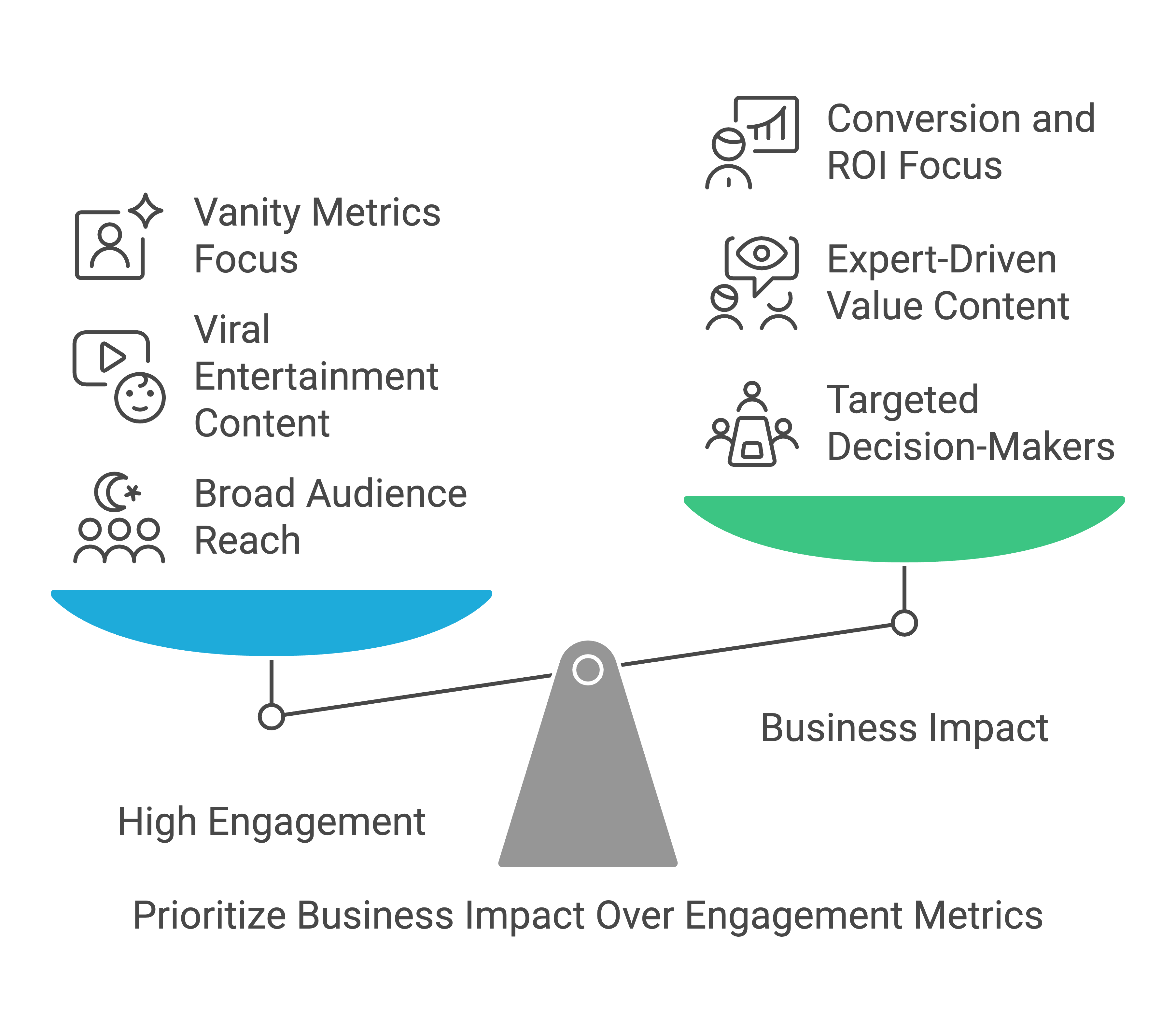
Consider two professionals:
- Person A: A LinkedIn creator with 500,000 followers and frequent viral posts. Their content sparks debate, and their DMs are flooded with praise. Yet, their sales pipeline remains dry.
- Person B: A consultant with just 3,000 connections but a strategic approach. They post infrequently, but when they do, their content speaks directly to high-value prospects. Every post generates leads.
Who’s actually winning? Likes and comments don’t pay the bills. Conversations, contracts, and conversions do.
1.3. Introducing Inversion Thinking: The Secret to Real LinkedIn Growth
During World War II, military strategists analyzed returning aircraft riddled with bullet holes. The logical solution? Reinforce those areas. But statistician Abraham Wald saw the flaw: the real issue wasn’t where the bullet holes were—it was where they weren’t. The planes that never returned were hit in critical, unseen areas.
This is inversion thinking in action—flipping the problem on its head. Instead of asking, “Where are the bullet holes?” ask, “Where are they missing?” Instead of optimizing for what’s visible (likes, comments, shares), optimize for what’s unseen:
- The silent lurkers who never engage but are actively considering your services.
- The high-value clients who read your content in stealth mode before making a decision.
- The posts you hesitate to write—because they might not go viral—but could land you your next big deal.
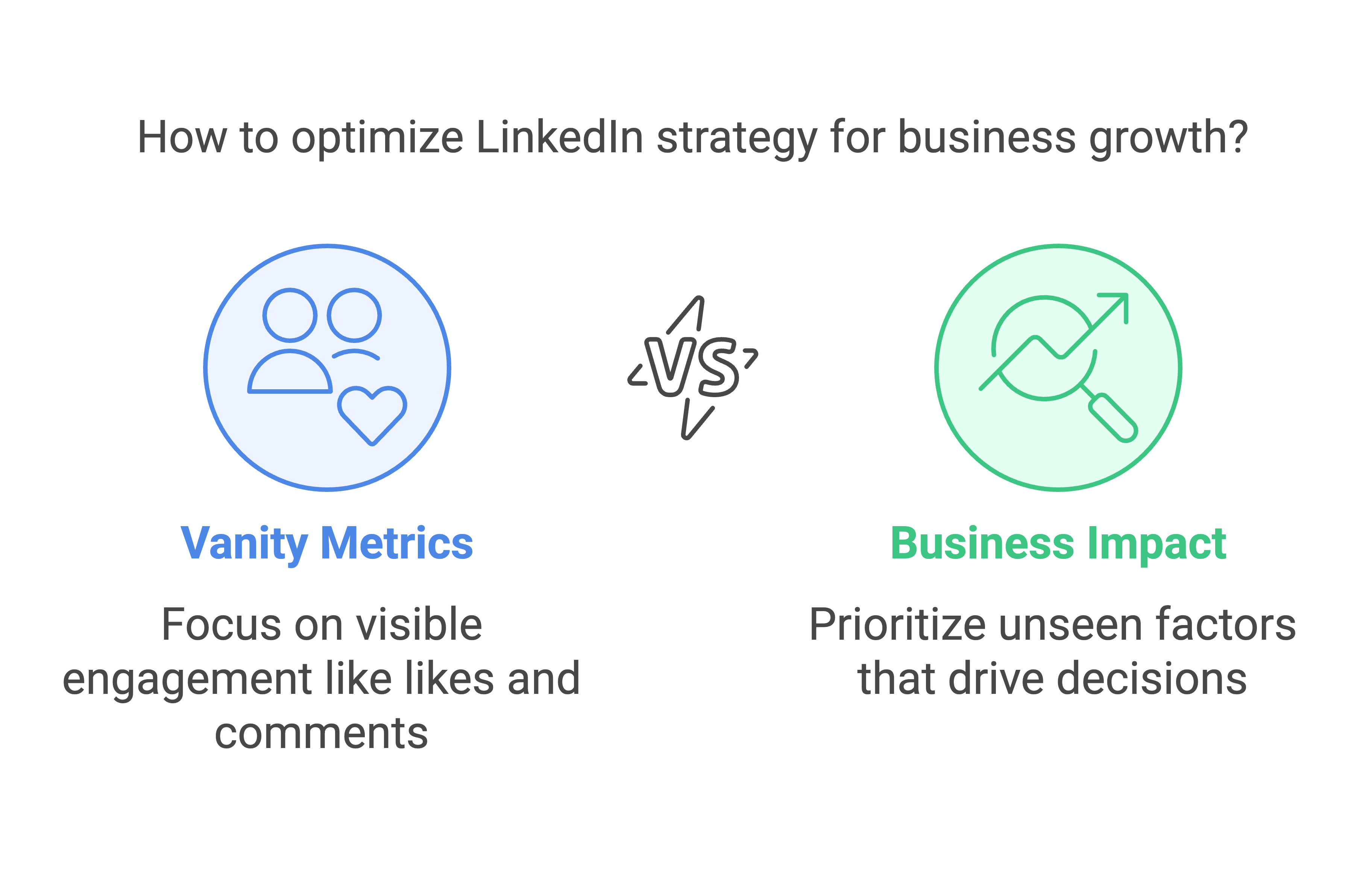
The real LinkedIn wins aren’t measured in vanity metrics. They happen in direct messages, in silent profile views, and in offline conversations. By shifting your perspective, you stop chasing attention and start attracting business.
2. The Survivorship Bias of LinkedIn Growth
2.1. What WWII Planes Teach Us About LinkedIn Strategy
During World War II, military engineers faced a critical problem: too many bombers were being shot down. To improve survival rates, they studied returning aircraft, mapping where bullets had struck. The logical solution? Reinforce those areas.
But mathematician Abraham Wald saw what others missed. The real issue wasn’t where the bullet holes were—it was where they weren’t. The planes that never returned had been hit in fatal spots. Reinforcing the areas with no damage was the key to survival.
The same flawed thinking dominates LinkedIn strategy. People analyze visible metrics—likes, comments, shares—without considering the invisible ones. They optimize for engagement without realizing that true business impact happens off the radar.
LinkedIn’s biggest wins come from what you don’t see:
- The profile visits from decision-makers who never interact publicly.
- The silent readers who consume your content but don’t engage.
- The direct messages that lead to closed deals, not viral posts.
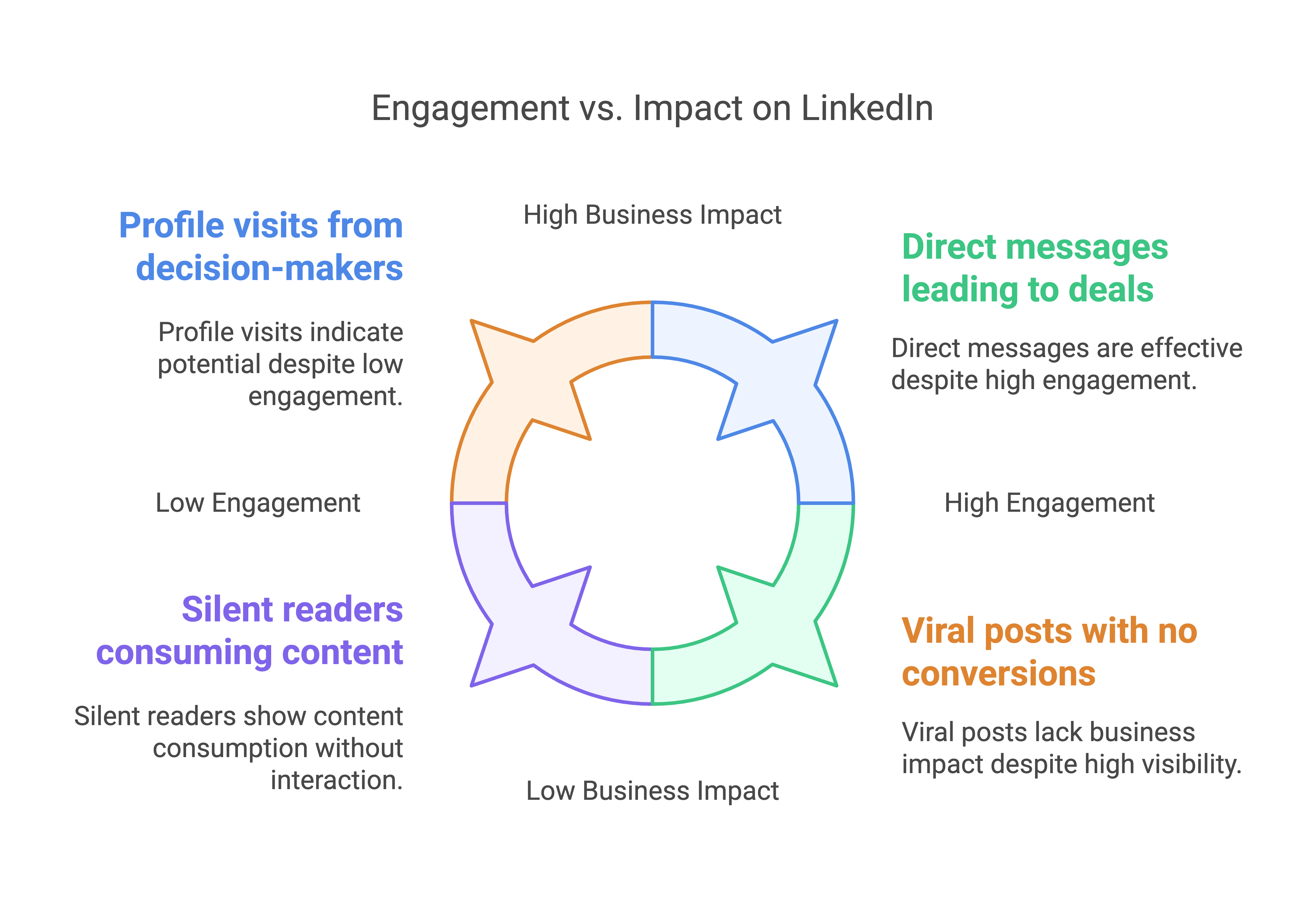
Just like the missing bullet holes on WWII planes, the most critical signals of success on LinkedIn are often the ones that go unnoticed.
2.2. Survivorship Bias Explained: The Hidden Pitfalls in Social Media Metrics
Survivorship bias is a cognitive trap where we only analyze success stories, ignoring the cases that failed. This happens constantly on LinkedIn.
People look at viral posts and assume:
✔️ More engagement = more credibility
✔️ More followers = more authority
✔️ More visibility = more business
But these assumptions ignore what’s missing from the data:
- How many viral creators never generate revenue?
- How many quiet professionals close million-dollar deals behind the scenes?
- How many potential clients consume your content without ever leaving a comment?
Measuring success only by what’s visible skews reality. Just because a post didn’t go viral doesn’t mean it didn’t work. And just because someone never commented doesn’t mean they weren’t influenced.
The people making real business decisions don’t always engage publicly. Understanding this bias is the key to seeing beyond LinkedIn’s surface-level metrics.
2.3. The Problem with Visibility: Why Focusing on What You See Leads to Failure
Social media conditions us to seek validation through visibility. The more reactions a post gets, the more valuable it seems. But focusing only on what’s seen leads to three major problems:
1. You Optimize for the Wrong Audience
Posts designed for mass engagement often attract the wrong people—competitors, recruiters, peers—rather than actual buyers. Viral success doesn’t guarantee business success.
2. You Ignore the Silent Buyers
High-value clients aren’t leaving fire emojis on your posts. They’re reading, evaluating, and reaching out when they’re ready. But if you measure success by comments alone, you’ll miss them entirely.
3. You Chase Short-Term Dopamine Instead of Long-Term Results
Likes and shares feel good, but they don’t close deals. The real LinkedIn wins happen in direct messages, discovery calls, and client conversions—none of which show up in your engagement metrics.
Chasing visibility leads to performative content that impresses the algorithm but doesn’t serve your business goals. True LinkedIn growth comes from impact, not impressions.
2.4. The Silent Majority: Who’s Watching But Not Engaging?
For every person who engages with your post, there are dozens—maybe hundreds—who don’t. This silent majority includes:
- Decision-makers vetting your expertise before reaching out.
- Potential clients who follow your content but never comment.
- Industry peers who respect your insights but never interact.
Most professionals assume that if someone isn’t liking or commenting, they aren’t interested. That’s a mistake. The absence of engagement does not mean the absence of impact.
How to Reach the Silent Majority:
- Track profile views. These are often better indicators of intent than likes.
- Optimize your LinkedIn profile. A strong profile converts silent visitors into leads.
- Send direct messages. If someone consistently views your content, initiate a conversation.
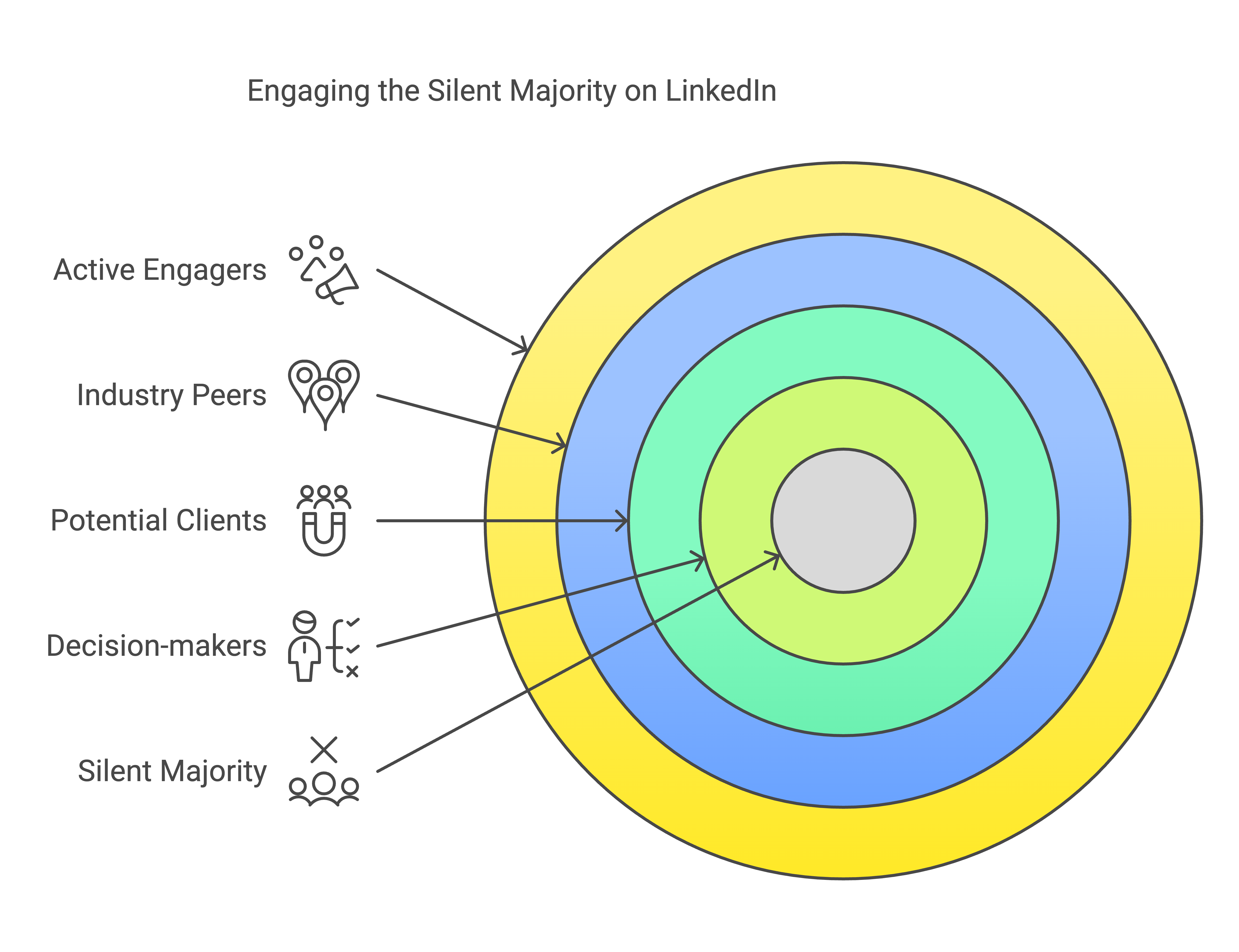
The loudest voices on LinkedIn don’t always drive the most business. The most valuable audience is often the quietest one. Recognizing and leveraging this reality shifts your LinkedIn strategy from vanity to value.
3. Rethinking LinkedIn Success: What Really Drives Business Growth
3.1. Beyond Likes and Comments: The True Indicators of Business Opportunities
Most LinkedIn users measure success by surface-level engagement: likes, comments, shares. While these metrics indicate visibility, they rarely correlate with actual revenue. True business opportunities stem from unseen interactions—profile visits, direct messages, silent followers evaluating your expertise.
Key indicators of LinkedIn-driven business growth:
- Inbound leads: How many decision-makers reach out to inquire about your services?
- Profile visits from high-value prospects: Are the right people looking at your profile?
- Direct messages from interested parties: Are conversations turning into business discussions?
- Off-platform impact: Are LinkedIn interactions leading to calls, proposals, and deals?
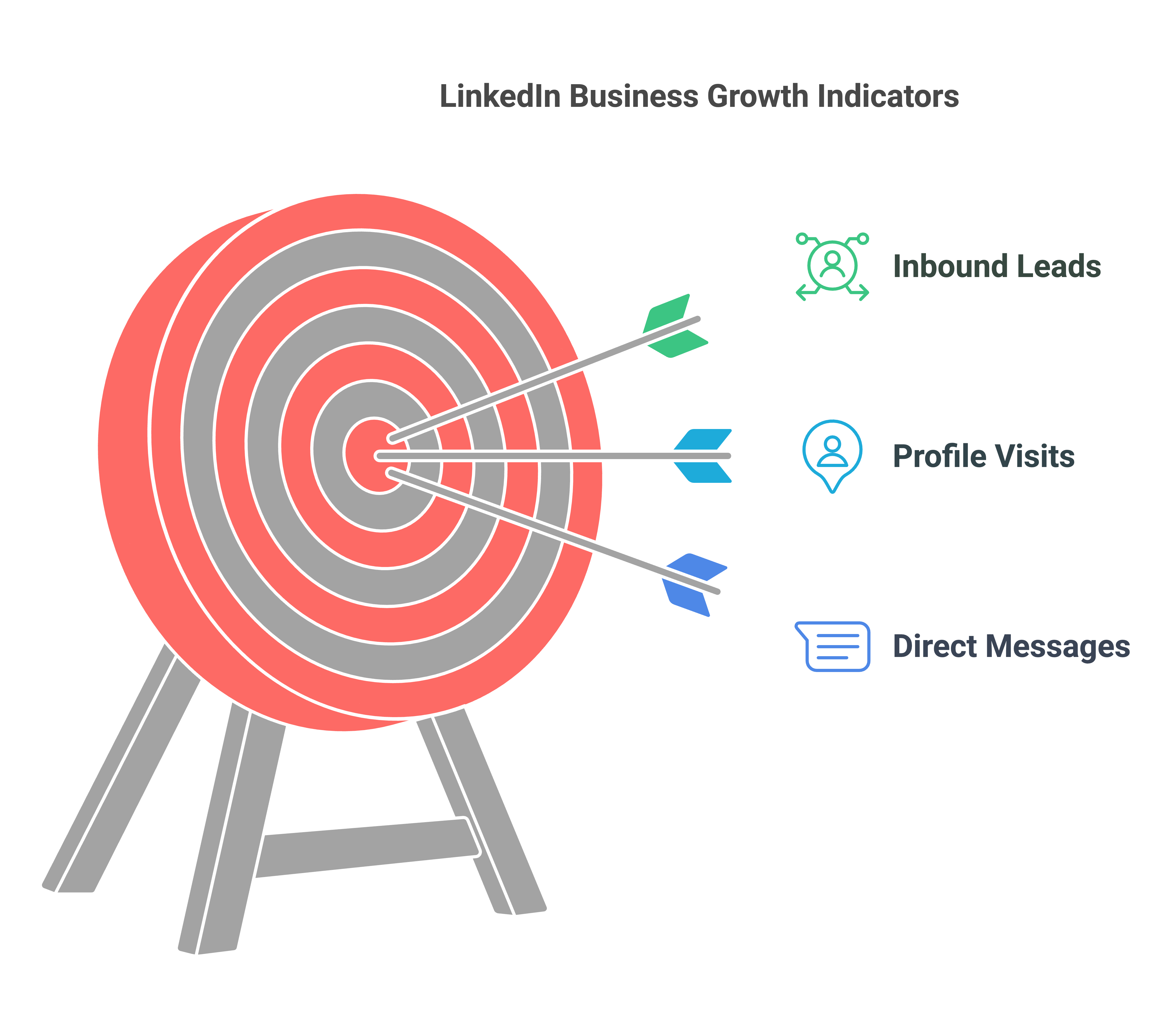
Shifting focus from public engagement to business-generating activities changes the way professionals approach LinkedIn. Instead of optimizing for applause, they optimize for outcomes.
3.2. Why Your Most Valuable Prospects Stay Silent
The professionals most likely to invest in high-ticket services or B2B solutions are rarely the ones engaging with every post. Executives, decision-makers, and budget-holders consume content strategically—they observe, evaluate, and reach out privately when the time is right.
Why do key decision-makers stay silent?
- They don’t want public attention. Engaging with your content signals interest, which competitors or colleagues might notice.
- They’re too busy to comment. Their priority isn’t adding to a thread—it’s solving a business problem.
- They prefer direct communication. Rather than commenting on a post, they’ll reach out privately when they’re ready.
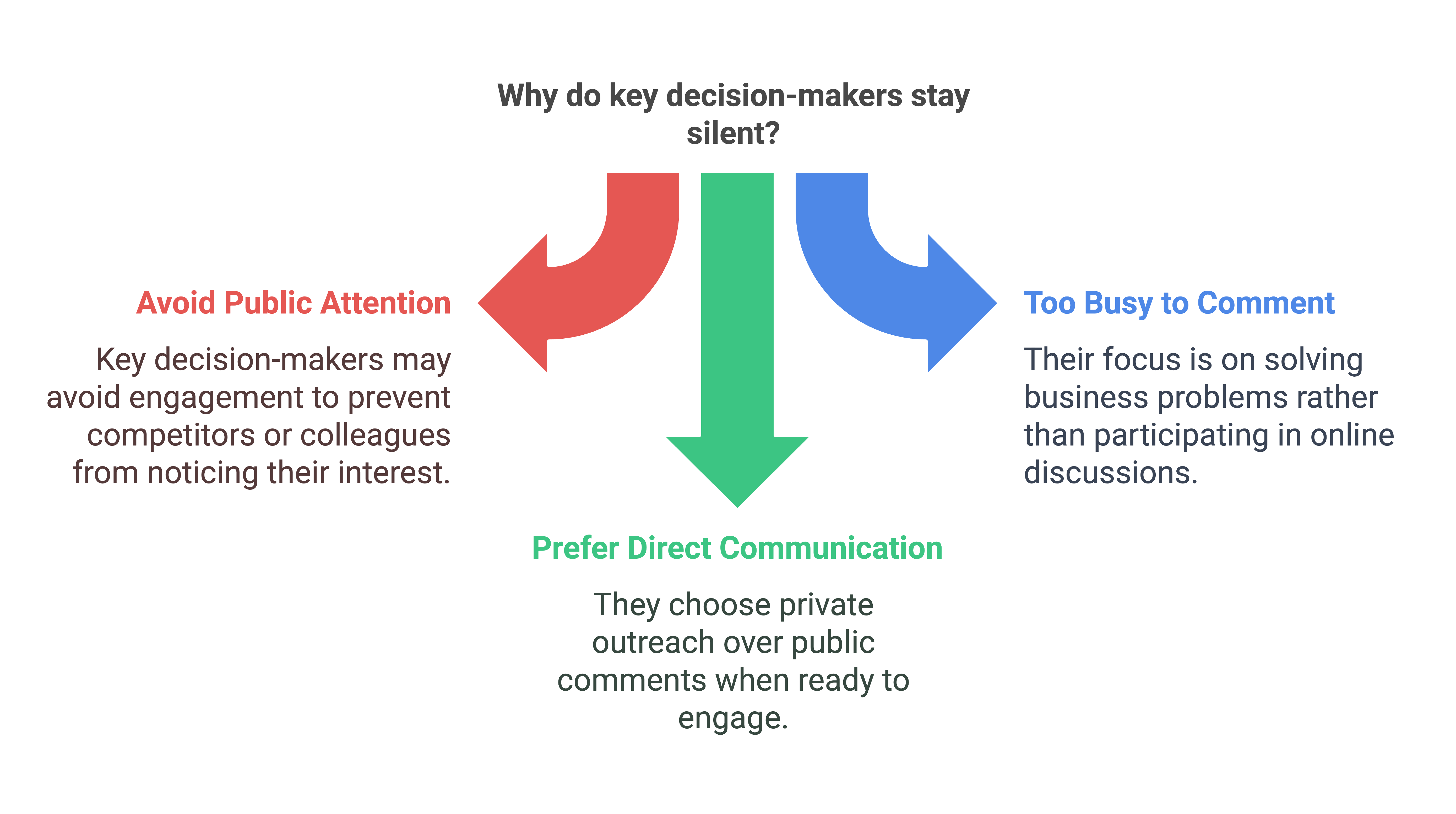
Relying solely on public engagement as a measure of success means overlooking these high-value, low-visibility prospects.
3.3. The Power of Lurkers: Understanding Buyer Psychology on LinkedIn
Lurkers—those who consume content without engaging—are among the most valuable audiences on LinkedIn. Unlike casual commenters, they take a strategic approach to content consumption, using LinkedIn as a silent research tool.
What do lurkers do before making a buying decision?
- Read multiple posts to assess credibility. They want to ensure consistency in expertise.
- Visit your profile to review experience and recommendations. They look for proof of success.
- Silently follow content over time to establish trust. Before reaching out, they evaluate your insights.
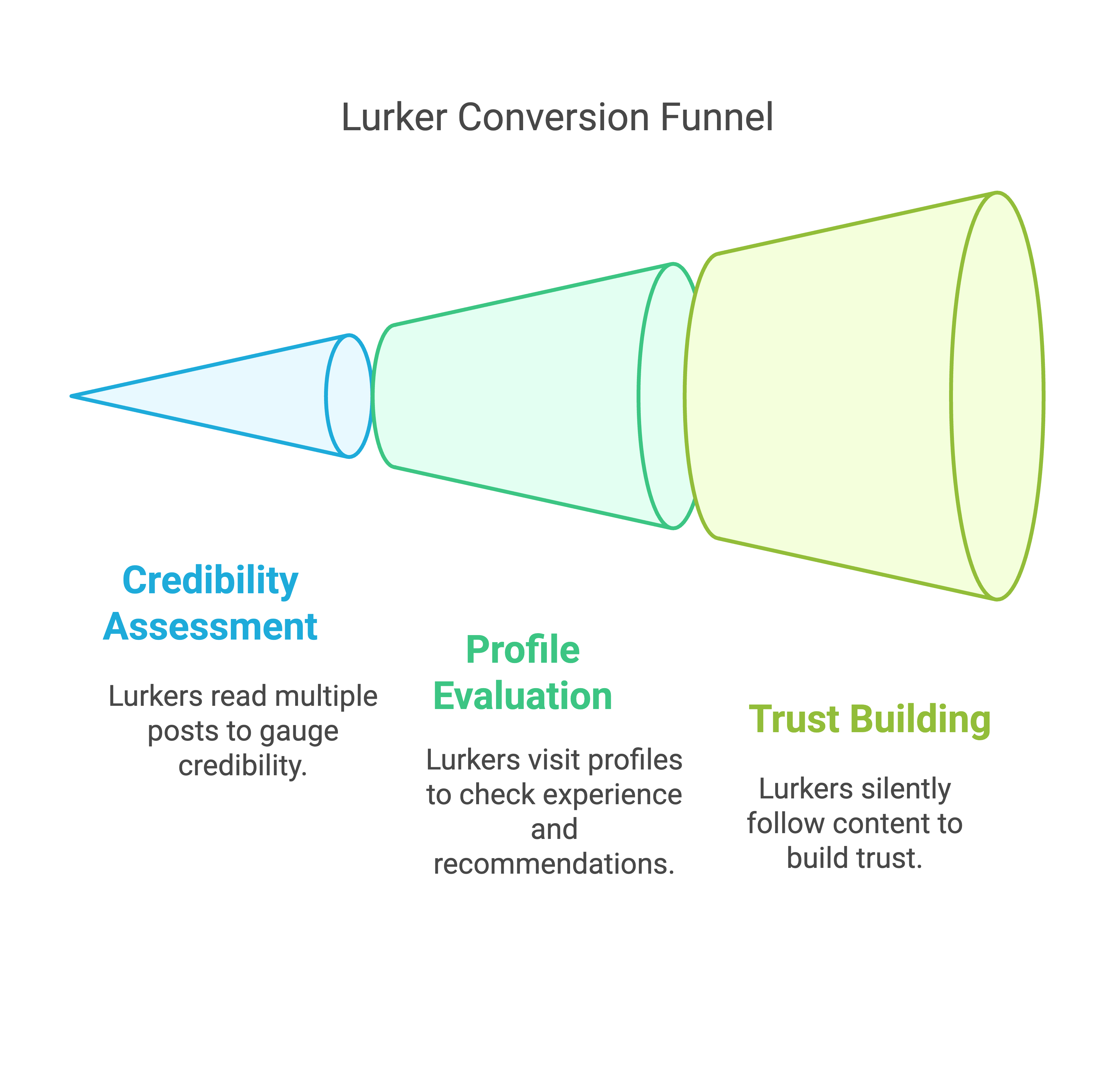
Understanding the power of lurkers changes the content strategy. Instead of writing for engagement, professionals write for trust-building and authority—positioning themselves as a solution provider rather than just a content creator.
3.4. The LinkedIn Profile as a Conversion Tool, Not a Vanity Showcase
A LinkedIn profile isn’t a résumé—it’s a landing page for converting profile visitors into clients. Yet, many professionals focus on listing past roles instead of making their value proposition clear.
Key elements of a profile optimized for business growth:
- Headline that speaks to the ideal client’s pain points. Instead of just a job title, it should communicate how you solve problems.
- About section that provides clarity and social proof. Prospects should immediately understand what you do, who you help, and why they should trust you.
- Call-to-action (CTA) guiding visitors to the next step. Whether it’s booking a call, sending a DM, or downloading a resource, the next step should be obvious.
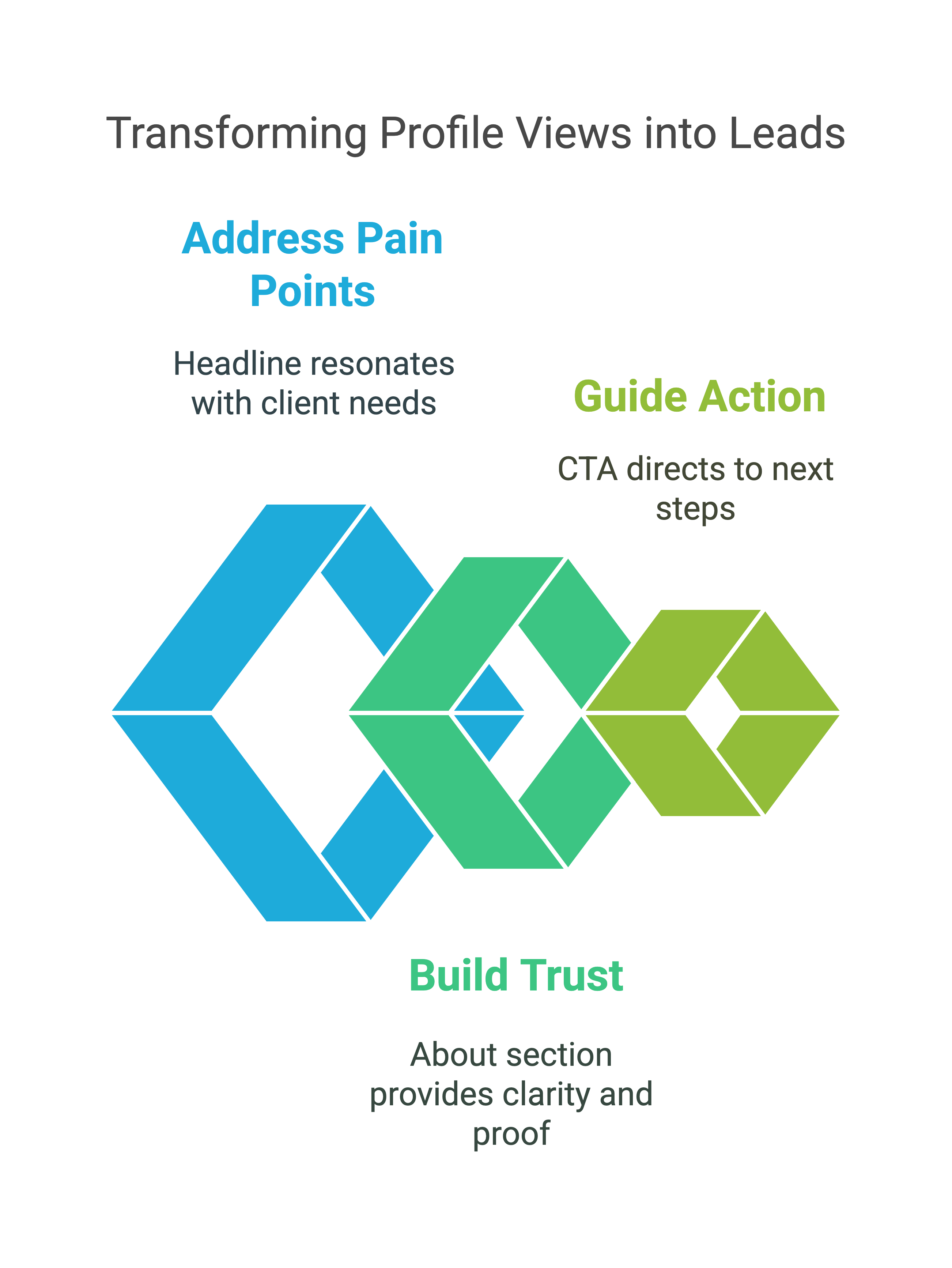
An optimized profile turns silent visitors into inbound leads—shifting LinkedIn from a networking tool into a revenue-generating asset.
4. Flip Your Perspective - 4 Ways to Win on LinkedIn
4.1. Stop Chasing Engagement—Start Chasing Conversations
LinkedIn engagement metrics—likes, comments, shares—are tempting distractions. They signal activity but don’t always translate into revenue. A post with thousands of reactions may boost visibility, but if it doesn’t spark conversations that lead to business, it’s just noise.
How to Identify and Engage Silent Buyers
High-value clients don’t always engage publicly. They consume content passively, evaluate credibility silently, and reach out when ready. To tap into this invisible audience:
- Monitor profile views—Frequent visits from decision-makers signal interest.
- Track repeat content consumers—If someone consistently views your posts but never interacts, they might be a warm lead.
- Use LinkedIn search—Identify potential clients who fit your ideal customer profile and proactively connect.
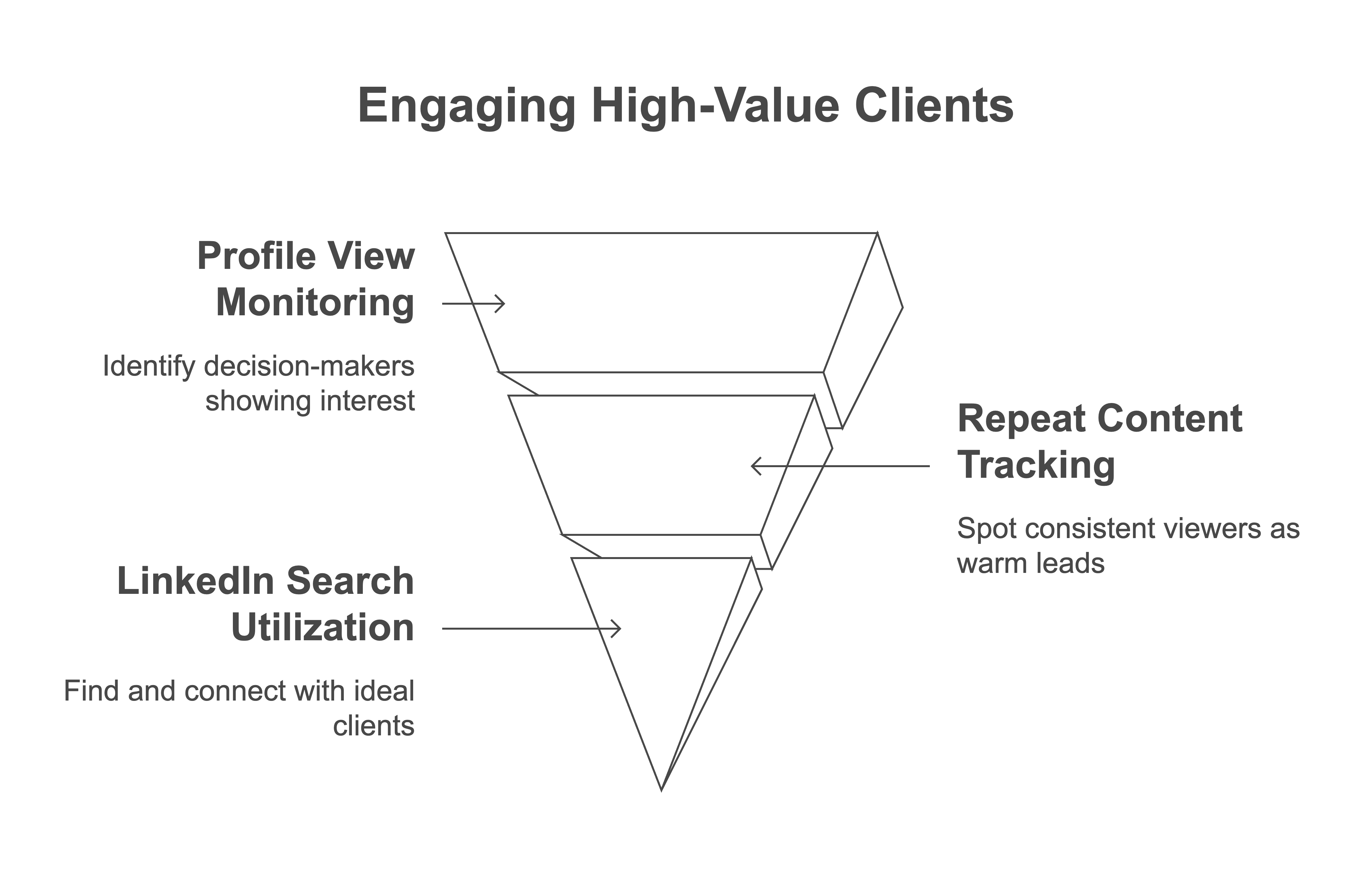
Using Direct Messages and Profile Visits as Sales Triggers
Instead of waiting for engagement, initiate conversations based on profile visits, mutual connections, and shared interests.
- Message people who view your profile—A simple “I noticed you checked out my profile—how can I help?” can open doors.
- Personalize connection requests—Avoid generic invites; reference mutual connections, shared interests, or recent content.
- Follow up strategically—If someone accepts your request, send a value-driven message rather than an immediate pitch.
Conversation Starters That Lead to Business Opportunities
Instead of cold pitching, use LinkedIn conversations to add value first. Effective openers include:
- “I saw your post on [topic]—really insightful. What’s your take on [related issue]?”
- “We share connections in [industry]. Curious—what’s the biggest challenge you’re tackling right now?”
- “I noticed you work in [industry]. I’ve helped companies in similar spaces—happy to share insights if useful.”
Meaningful conversations drive business far more effectively than chasing superficial engagement.
4.2. Stop Writing for LinkedIn—Start Writing for Decision-Makers
Most LinkedIn content is designed for engagement, not conversion. Viral posts often attract peers, not potential clients. Writing for decision-makers requires a strategic shift.
Why Your Biggest Clients Might Never Like or Comment
Senior executives and decision-makers rarely engage publicly. Instead, they:
- Read in stealth mode—They consume content for insights but avoid public interaction.
- Vet professionals through content history—They assess credibility over time.
- Prefer direct outreach—They initiate conversations privately rather than engaging in comment threads.
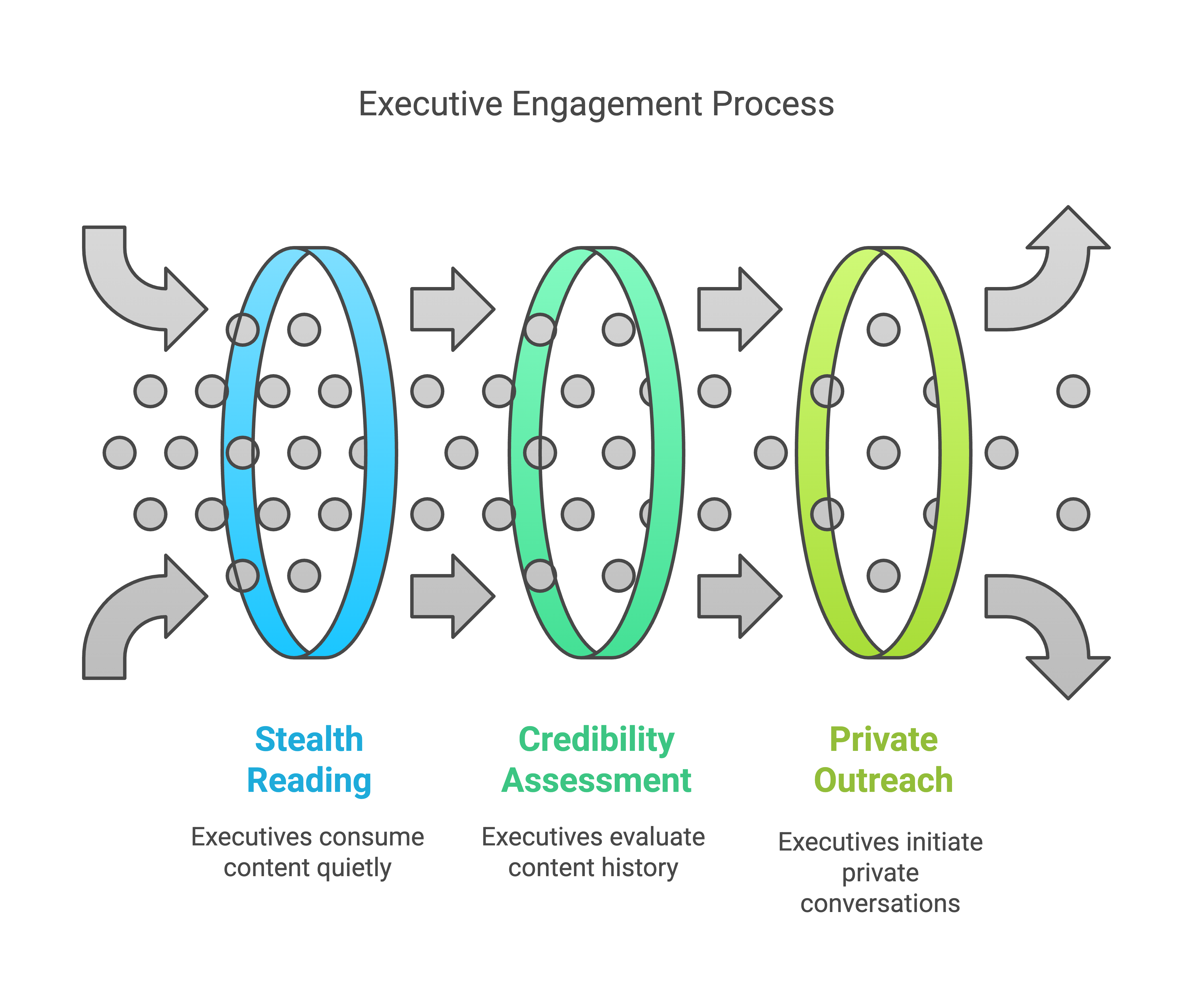
Writing for Trust, Not Just Algorithmic Reach
To attract high-value clients, content must demonstrate expertise, authority, and problem-solving ability. Effective strategies include:
- Industry insights: Address pain points your ideal clients face.
- Success stories: Share case studies without giving away proprietary details.
- Educational content: Teach rather than just entertain—actionable takeaways matter more than clever hooks.
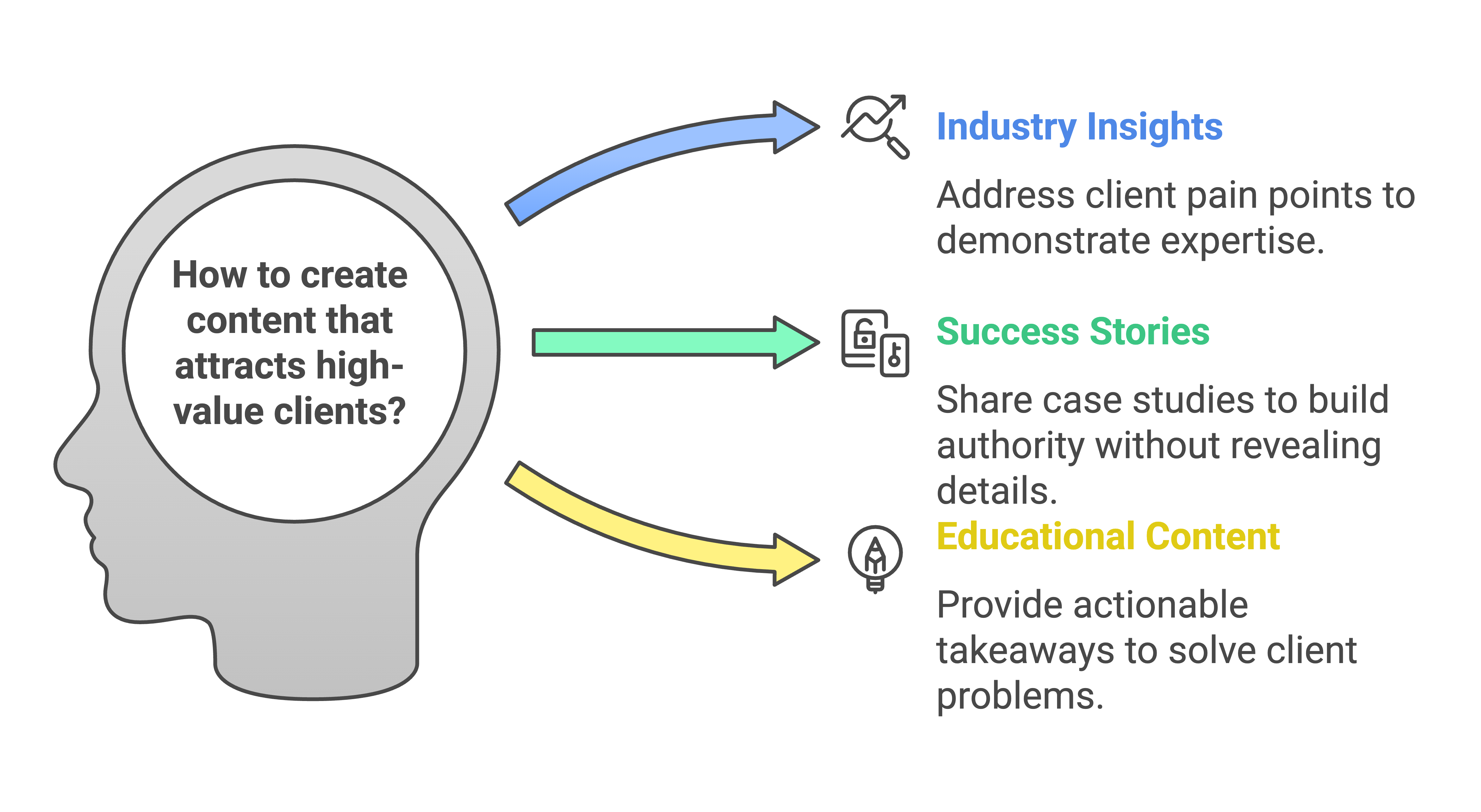
Structuring Posts for Silent Buyers
Optimized content follows a simple structure:
- Hook—Grab attention with a compelling insight or question.
- Problem—Address a challenge decision-makers face.
- Solution—Provide a high-level framework for solving the issue.
- Call to Action—Invite further discussion through comments or direct messages.

Content written for credibility and conversions attracts decision-makers far more effectively than content optimized for engagement.
4.3. Stop Measuring Success by Post Performance—Measure It by Revenue
LinkedIn’s algorithm rewards engagement, but likes don’t pay bills. Professionals who generate business from LinkedIn track different metrics.
How to Track ROI from LinkedIn
Instead of measuring post engagement, focus on:
- Inbound messages from high-intent prospects.
- Profile views from key decision-makers.
- Connection requests from potential clients.
- Discovery calls and booked meetings.
- Closed deals that originated from LinkedIn.
The Metrics That Actually Matter
Instead of tracking vanity metrics, focus on:
- Profile conversion rate (profile views → direct messages → business discussions).
- DM-to-meeting ratio (how many conversations lead to calls).
- LinkedIn-generated revenue (closed deals originating from LinkedIn).
By shifting measurement from engagement to business outcomes, professionals make LinkedIn a revenue-generating tool rather than an entertainment platform.
4.4. Stop Assuming Your Audience Knows What You Do—Spell It Out
Many professionals assume their LinkedIn audience understands what they offer. They don’t.
Decision-makers don’t have time to decode vague personal branding. If your profile and content don’t clearly communicate what you do, you’re losing opportunities.
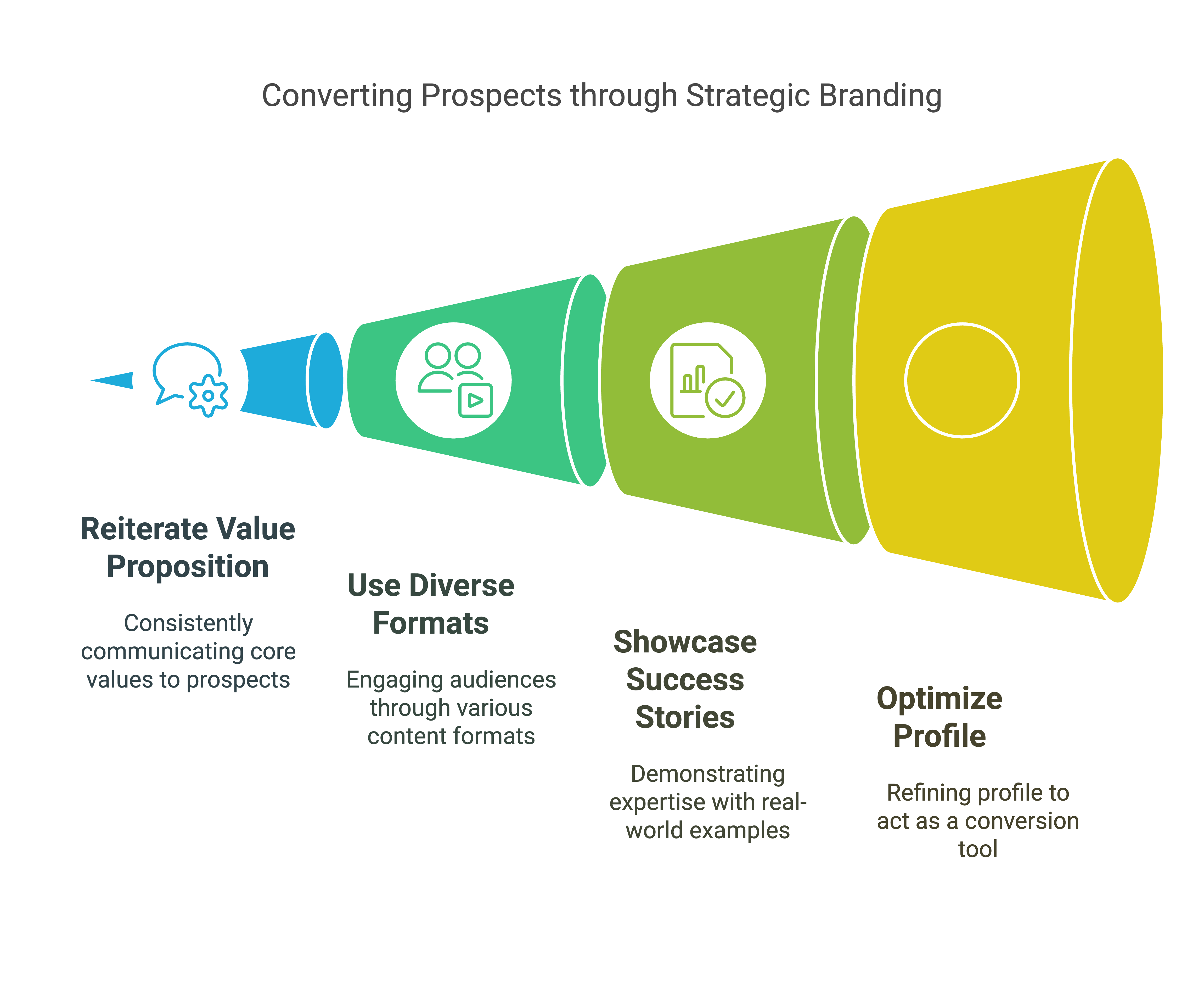
Why Repetition is Key in Positioning Your Offer
Prospects rarely act on the first exposure to a service. It takes multiple touchpoints before they take action.
To stay top of mind:
- Reiterate your value proposition frequently.
- Use different formats (posts, videos, articles) to reinforce key messages.
- Showcase results and client success stories consistently.
Showcasing Your Expertise Through Case Studies and Client Wins
Rather than just saying you’re an expert, prove it. Effective ways to demonstrate credibility:
- Client success stories: “A client struggled with X. Here’s how we solved it.”
- Before-and-after transformations: “Company A was losing leads. After our solution, they saw a 3X increase.”
- Common industry mistakes and how to fix them.
Clarity converts.
Optimizing Your Profile for Conversions
Your LinkedIn profile should function as a landing page, not a résumé.
Key elements of a high-converting profile:
- Headline: Clearly state what you do and who you help. Example: “Helping B2B SaaS companies generate $500K+ in pipeline through LinkedIn.”
- About section: Speak directly to your ideal client’s pain points, not just your career history.
- Call-to-action: Make it easy to take the next step (book a call, visit a website, send a message).
By refining messaging and repetition, professionals attract the right clients effortlessly.
5. Common LinkedIn Growth Mistakes and How to Avoid Them
5.1. The Engagement Trap: Why Viral Posts Don’t Equal Business Wins
A post goes viral. Thousands of likes, hundreds of comments, and profile views skyrocket. It feels like success—until reality sets in. No inbound leads. No meaningful business conversations. No revenue impact.
This is the Engagement Trap—a dangerous cycle where professionals optimize for LinkedIn’s algorithm instead of real business growth.
Why Going Viral Can Be a Distraction
- The wrong audience engages—Peers, job seekers, and casual LinkedIn users react, while decision-makers remain silent.
- Engagement skews perception—A high-performing post creates an illusion of authority without actual business value.
- Time and effort are misallocated—Hours are spent responding to comments instead of closing deals.
Breaking Free from the Engagement Trap
- Prioritize quality over reach—Content should serve the right audience, not just attract the biggest crowd.
- Focus on conversations, not comments—A single meaningful DM is more valuable than 1,000 likes.
- Measure success differently—Track profile visits from key prospects, inbound messages, and business opportunities instead of vanity metrics.
Chasing engagement for its own sake dilutes LinkedIn’s potential as a business tool. The goal is to attract buyers, not just spectators.
5.2. The “Popular vs. Profitable” Content Dilemma
Content that performs well on LinkedIn isn’t always content that converts. There’s a fundamental difference between what’s popular and what’s profitable.
Characteristics of Popular Content
- Entertaining or controversial—Sparks debate but doesn’t drive action.
- Relatable but vague—Appeals to a wide audience but lacks strategic value.
- Algorithm-driven—Structured to generate engagement rather than deliver insights.
Characteristics of Profitable Content
- Industry-specific and actionable—Addresses real business challenges.
- Decision-maker focused—Written for those who control budgets, not just LinkedIn users at large.
- Positioning-oriented—Clearly communicates expertise and solutions.
How to Shift from Popular to Profitable
- Write for the ideal client, not the algorithm—Define who needs to see your content and tailor messaging to them.
- Balance visibility with authority—A mix of high-level industry insights and niche problem-solving establishes expertise.
- Make content conversion-friendly—End posts with calls to action that invite deeper engagement beyond the platform.
Focusing on profitable content ensures LinkedIn efforts lead to real business growth, not just fleeting recognition.
5.3. The Mistake of Only Engaging With the Same Network
Many LinkedIn users interact with the same circle repeatedly, reinforcing familiarity but limiting business opportunities. This creates a content echo chamber, where engagement stays high, but audience expansion stalls.
Signs You’re Stuck in an Echo Chamber
- The same people like and comment on every post.
- Content rarely reaches new decision-makers.
- Inbound opportunities come from peers rather than potential clients.
How to Expand Beyond the Existing Network
- Connect intentionally with industry decision-makers—Actively grow the network by engaging with potential buyers.
- Engage outside your usual circle—Commenting on content from industry leaders exposes your expertise to new audiences.
- Diversify content formats—Articles, videos, and collaborative posts increase visibility in different feeds.
Expanding reach strategically ensures content is seen by the right people—not just familiar faces.
5.4. Neglecting Direct Outreach: The Power of Personalized Messaging
Many professionals rely solely on content to generate business, expecting inbound leads to appear. This passive approach ignores LinkedIn’s greatest strength: direct outreach.
Why Direct Outreach Works
- It cuts through the noise—Unlike posts, direct messages create one-on-one engagement.
- It builds relationships faster—A personalized message accelerates trust and credibility.
- It leads directly to business discussions—DMs convert silent prospects into active leads.
How to Craft Effective LinkedIn Outreach Messages
- Personalize the opening—Reference a shared connection, recent post, or mutual interest.
- State the reason for reaching out—Be clear about the intent without pitching immediately.
- Ask an engaging question—Encourage a response by making the message conversational.
- End with a low-friction call to action—Suggest a short chat or ask about their current challenges.
Example of a Non-Salesy Outreach Message
Hi [Name], I came across your profile and saw we share a background in [industry]. I really enjoyed your recent post on [topic]—great insights. Curious, how are you seeing [specific industry challenge] play out on your end?
Effective outreach isn’t about immediate conversion—it’s about starting the right conversations. Combining content strategy with direct engagement ensures LinkedIn is a lead-generation engine, not just a branding tool.
6. FAQs: Answering the Most Common LinkedIn Growth Questions
6.1. How do I know if my LinkedIn strategy is working?
Success on LinkedIn isn’t measured by engagement alone. True effectiveness comes from business impact, not vanity metrics.
Key Performance Indicators (KPIs) That Matter:
- Profile Views from Decision-Makers – Are the right people viewing your profile? A high volume of views from non-relevant users means your content isn’t targeting the right audience.
- Inbound Messages and Connection Requests – Are prospects reaching out after seeing your content? If not, your messaging might be unclear or failing to drive action.
- DM-to-Meeting Conversion Rate – Are direct conversations leading to calls, demos, or proposals? Track how many interactions result in meaningful business discussions.
- Revenue Generated from LinkedIn – Are you closing deals or landing clients directly from LinkedIn interactions? This is the ultimate measure of success.
Simple Audit: Is Your Strategy Working?
- Are you attracting decision-makers, not just industry peers?
- Are your posts leading to direct conversations and inquiries?
- Have you secured business opportunities from LinkedIn activity?
If the answer to these questions is no, it’s time to refine your approach.
6.2. What if I don’t get many likes or comments? Does that mean my content is failing?
Lack of engagement doesn’t mean lack of impact. Many high-value prospects read in stealth mode, evaluating you without interacting.
Why Low Engagement is Misleading
- Decision-makers rarely engage publicly – They prefer private conversations over commenting on posts.
- Viral posts don’t always attract buyers – High engagement can come from peers, not potential clients.
- Silent readers are still influenced – Many reach out directly after consuming content over time.
Alternative Success Signals
- Increased profile views from prospects
- More DMs from interested buyers
- Higher connection requests from ideal clients
- Inquiries that reference your past posts
Focus on conversions, not likes. A post with 10 likes but one lead is more valuable than a viral post with no business impact.
6.3. How often should I post on LinkedIn for business growth?
Consistency is key, but quality outweighs quantity. Posting five times a week with no strategy won’t generate results. Posting twice a week with high-value insights will.
Recommended Posting Frequency
- Minimum: 2-3 times per week to stay visible.
- Optimal: 3-5 times per week for momentum.
- Sustainable: What you can manage without sacrificing quality.
What Matters More Than Frequency?
- Relevance: Is the content useful to your target audience?
- Positioning: Does it reinforce your expertise?
- Call-to-Action (CTA): Does it guide the reader to the next step?
Posting daily means nothing if the content isn’t attracting the right people. Prioritize strategic, well-crafted posts over sheer volume.
6.4. How can I convert LinkedIn connections into real business opportunities?
Connections alone don’t drive revenue. Conversion happens in conversations.
Steps to Turn Connections into Clients
- Warm Up the Relationship
- Engage with their content before messaging.
- Personalize interactions—don’t send generic pitches.
- Start Conversations Without Selling
- Ask about their challenges, goals, or industry trends.
- Offer insights or value before introducing your offer.
- Move the Conversation Off LinkedIn
- Suggest a quick call to discuss their needs.
- Provide clear next steps—don’t leave them guessing.
Example Message That Works
“Hi [Name], I noticed we both focus on [industry]. I’ve been working with companies tackling [challenge], and I’d love to hear your take on it. Open to a quick chat?”
The goal is to build trust first, not pitch immediately. Conversations create opportunities.
6.5. What’s the best way to approach a decision-maker on LinkedIn?
Decision-makers receive countless connection requests and pitches. Generic outreach won’t work—personalization and value-driven messaging will.
How to Get Noticed by Decision-Makers
- Make Your Profile Worth Their Time
- Optimize your headline and summary to show exactly how you help.
- Highlight case studies or results that are relevant to them.
- Send a Personalized Connection Request
- Reference a shared connection or recent content they posted.
- Keep it short, specific, and non-salesy.
- Engage With Their Content First
- Comment on their posts with meaningful insights.
- Show genuine interest before reaching out directly.
Example of a Strong Initial Message
“Hi [Name], I saw your post on [topic] and completely agree with your point on [specific insight]. I’ve worked with companies tackling this issue, and I’d love to hear how you approach it. Open to connecting?”
Personalization increases response rates. Decision-makers engage when they see relevance and value in the conversation.
7. Conclusion: Shift Your Focus, See Real Results
7.1. The Power of Inversion Thinking: Final Thoughts
Traditional LinkedIn growth strategies focus on what’s visible—likes, comments, and shares. But the most significant business wins come from what’s unseen—silent lurkers, direct conversations, and off-platform conversions.
Inversion thinking shifts the approach: instead of optimizing for engagement, professionals optimize for business outcomes. Instead of chasing popularity, they focus on profitability.
High-value clients don’t necessarily engage publicly. They observe, evaluate, and reach out when they see consistent expertise. True LinkedIn success isn’t about being the loudest voice in the room—it’s about being the most trusted authority in your space.
Why This Framework?
Most professionals optimize for engagement metrics instead of business growth. This framework flips the script, helping you move from vanity metrics to real revenue.
📌 The 4-Step LinkedIn Growth Framework
| Step | Focus | Actionable Tactics | Success Metric |
|---|---|---|---|
| 1. Visibility | Get on the radar of the right people | - Optimize your profile |
- Write posts that attract decision-makers
- Engage strategically (comments, shares) | Profile views from potential clients & decision-makers | | 2. Engagement → Conversations | Turn passive interest into direct interactions | - DM people who view your profile
- Track silent followers & engage them
- Move public interactions into private DMs | DMs with potential leads & warm conversations | | 3. Authority & Trust | Position yourself as the go-to expert | - Share case studies & client wins
- Post problem-solving content
- Repeat your offer frequently | Inbound leads & referrals | | 4. Monetization | Convert visibility into revenue | - Offer a clear service/product
- Include a CTA in your content
- Follow up with leads consistently | Revenue growth & closed deals |
🔹 Step 1: Visibility—Be Seen by Decision-Makers
Goal: Increase your presence in front of high-value prospects.
🔸 Profile Optimization
- Use a headline that speaks to your audience's pain points.
- Your About section should highlight who you help and how.
- Make sure your services & links are clearly listed.
🔸 Strategic Posting
- Post problem-solving content for your audience.
- Avoid viral fluff—focus on value-driven insights.
- Use storytelling & case studies to demonstrate expertise.
🔸 Engage with the Right People
- Comment on your ideal clients’ posts.
- Share industry insights and tag relevant professionals.
✅ Success Metric: Profile views from decision-makers & ideal clients.
🔹 Step 2: Engagement → Conversations
Goal: Convert passive engagement into private conversations.
🔸 DM People Who View Your Profile
- Message viewers with:
👉 “Hey [Name], saw you checked out my profile—what brought you here?”
👉 “Noticed you engaged with my post—what’s your take on [topic]?”
🔸 Track Silent Followers & Engage Them
- Look at who regularly follows but never engages.
- Send a personalized connection request to warm them up.
🔸 Move Public Interactions into Private DMs
- If someone comments on your post, reply in the comments and follow up in DMs.
✅ Success Metric: More DM conversations with potential leads.
🔹 Step 3: Authority & Trust—Become the Go-To Expert
Goal: Make it obvious that you’re the best at what you do.
🔸 Post Client Wins & Case Studies
- Share before-and-after results.
- Use real-world numbers & transformations.
🔸 Post Thought Leadership Content
- Address common industry pain points.
- Offer unique insights instead of generic advice.
🔸 Repeat Your Offer Frequently
- Every 3-5 posts should subtly remind people of what you do.
- Example: “I help [target audience] solve [problem] and generate [results]. DM me if you want to discuss.”
✅ Success Metric: More inbound leads & referrals.
🔹 Step 4: Monetization—Turn Attention into Revenue
Goal: Convert engagement into real business deals.
🔸 Have a Clear Offer & CTA
- Don’t assume people know what you do—spell it out.
- Include a CTA in your posts:
👉 “DM me if you want to chat about [service].”
👉 “I have 3 slots open for [offer]. Let’s talk.”
🔸 Follow Up with Warm Leads
- Most deals happen in the follow-up.
- If someone shows interest, check in:
👉 “Hey [Name], wanted to see if [problem] is still a challenge for you.”
🔸 Measure Success by Revenue, Not Likes
- Track clients signed, deals closed, revenue generated.
- Focus on what moves your business forward.
✅ Success Metric: More clients, more deals, more revenue.
🚀 The LinkedIn Growth Formula: The Shift from Vanity to Value
✅ Visibility → Conversations → Authority → Monetization
❌ Stop:
- Chasing likes & comments
- Posting for algorithms
- Measuring success by vanity metrics
✅ Start:
- Focusing on decision-makers
- Turning engagement into conversations
- Measuring success by revenue & business impact
Follow this framework, and LinkedIn will become your best lead-generation tool—not just another dopamine hit. 🔥
